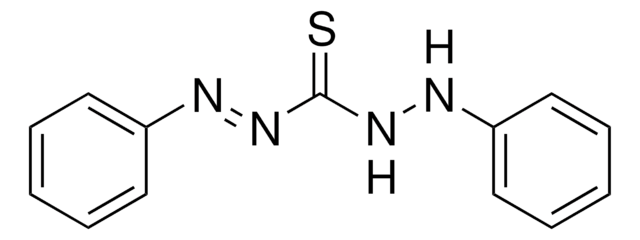15338
Blei(II)-Oxid
puriss. p.a., ≥99.0% (KT), yellow
About This Item
Empfohlene Produkte
Dampfdruck
10 mmHg ( 0 °C)
Qualität
puriss. p.a.
Assay
≥99.0% (KT)
Form
powder
Verunreinigungen
≤0.001% total nitrogen (N)
Farbe
yellow
pH-Wert
9.9 (20 °C, 100 g/L)
mp (Schmelzpunkt)
886 °C (lit.)
Anionenspuren
chloride (Cl-): ≤20 mg/kg
Kationenspuren
Ca: ≤10 mg/kg
Cd: ≤5 mg/kg
Co: ≤5 mg/kg
Cr: ≤5 mg/kg
Cu: ≤5 mg/kg
Fe: ≤10 mg/kg
K: ≤50 mg/kg
Mg: ≤5 mg/kg
Mn: ≤5 mg/kg
Na: ≤50 mg/kg
Ni: ≤5 mg/kg
Zn: ≤5 mg/kg
SMILES String
O=[PbH2]
InChI
1S/O.Pb
InChIKey
YEXPOXQUZXUXJW-UHFFFAOYSA-N
Suchen Sie nach ähnlichen Produkten? Aufrufen Leitfaden zum Produktvergleich
Verwandte Kategorien
Allgemeine Beschreibung
Lead(II) oxide is a crystalline solid, which can be prepared by decomposition of lead carbonate or by heating molten lead in the presence of air. It can be used in the synthesis of lead(II) ethanoate by reaction with ethanoic acid.
Signalwort
Danger
Gefahreneinstufungen
Acute Tox. 4 Inhalation - Acute Tox. 4 Oral - Aquatic Acute 1 - Aquatic Chronic 1 - Carc. 2 - Lact. - Repr. 1A - STOT RE 1
Zielorgane
Central nervous system,Kidney,Blood
Lagerklassenschlüssel
6.1D - Non-combustible acute toxic Cat.3 / toxic hazardous materials or hazardous materials causing chronic effects
WGK
WGK 3
Flammpunkt (°F)
Not applicable
Flammpunkt (°C)
Not applicable
Analysenzertifikate (COA)
Suchen Sie nach Analysenzertifikate (COA), indem Sie die Lot-/Chargennummer des Produkts eingeben. Lot- und Chargennummern sind auf dem Produktetikett hinter den Wörtern ‘Lot’ oder ‘Batch’ (Lot oder Charge) zu finden.
Besitzen Sie dieses Produkt bereits?
In der Dokumentenbibliothek finden Sie die Dokumentation zu den Produkten, die Sie kürzlich erworben haben.
Kunden haben sich ebenfalls angesehen
Unser Team von Wissenschaftlern verfügt über Erfahrung in allen Forschungsbereichen einschließlich Life Science, Materialwissenschaften, chemischer Synthese, Chromatographie, Analytik und vielen mehr..
Setzen Sie sich mit dem technischen Dienst in Verbindung.













